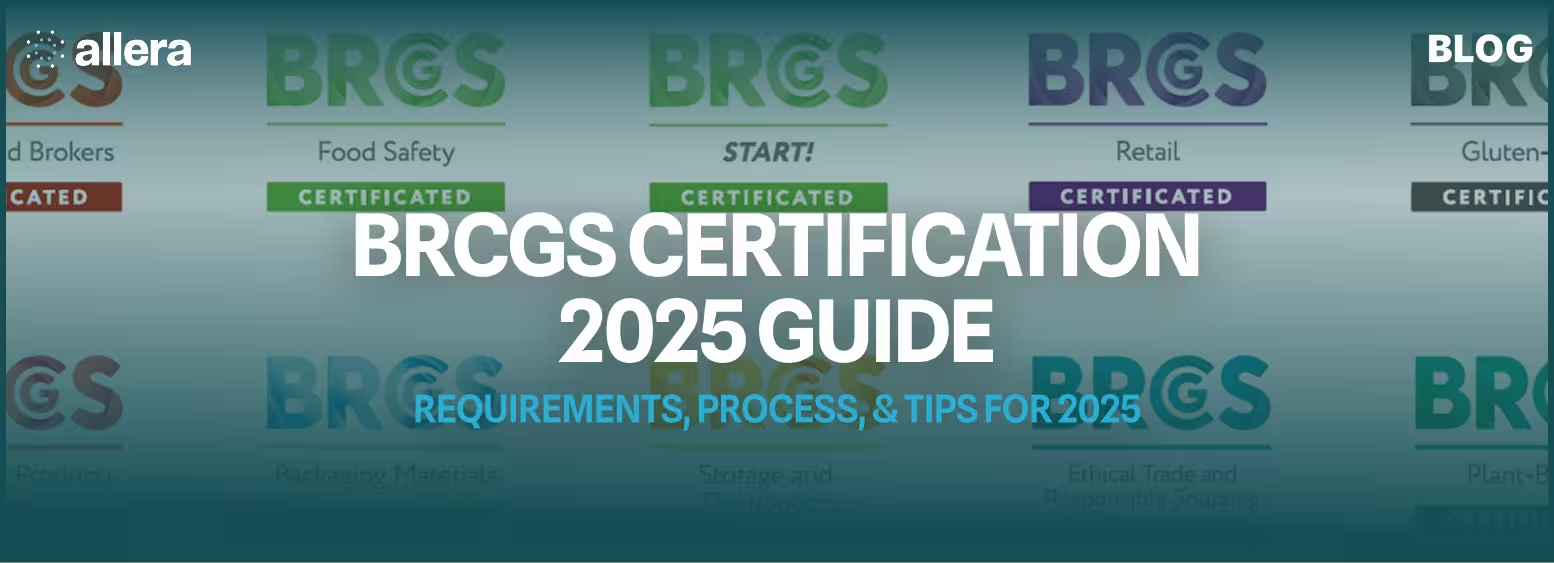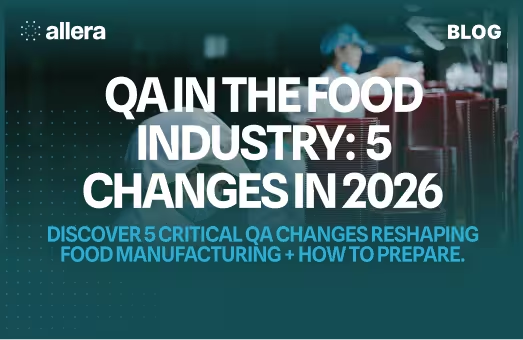

BRCGS Certification: Requirements, Process, & Tips for 2025

Key takeaways
- Certification with BRCGS helps you meet globally recognized food safety standards and boost brand credibility.
- A thorough gap analysis can highlight critical practice areas, ensuring you address potential weak points early.
- Engaging your entire team—from senior management to line workers—builds a culture of continuous improvement.
- Having a solid documentation system makes BRC audits more efficient and helps avoid last-minute scrambling.
- Digital innovations, training programs, and expert insights modernize your approach for 2025 and beyond.
Gaining the BRCGS certification can become easier than you think once you have a clear roadmap. This global standard not only helps you align with best practices, it also reassures your customers and supply chain partners that your facilities meet the highest food safety benchmarks. In this guide, you will explore how to get ready, which requirements matter, and the best ways to maintain certification long after you pass that first audit. If you are looking to raise the bar on food safety and quality in your facility, keep reading.
Understand the BRCGS Certification
The BRCGS Global Standard (historically referred to as BRC) is one of the world’s most recognized benchmarks for food safety. It gives you a structured set of requirements to help protect consumers, reduce product recalls, and build trust across the supply chain. If you are working in food manufacturing, you already know that maintaining BRC certification goes beyond a simple checkbox exercise. It is about consistently showing that your process meets stringent international standards.
Why BRCGS matters in food manufacturing
When your facility obtains a recognized certification program like BRCGS, you automatically align with a globally accepted benchmark.
BRCGS standards are used by 30k–36k+ sites worldwide and are widely accepted by major retailers. (BRCGS Annual Report).
By meeting BRCGS requirements, you also:
- Show prospective clients that you follow recognized best practices.
- Improve communication across the supply chain.
- Identify hazards early and build consistent processes to tackle them.
Ultimately, the program assures buyers that you, as a supplier, uphold stringent standards.
Origins and evolution of BRCGS
The British Retail Consortium (BRC) first introduced the Global Standard for Food Safety in 1998 to ensure consistent quality and safety across supply chains. In 2019, it was rebranded as BRCGS—Brand Reputation through Compliance Global Standards—to reflect its global reach and broader scope. Today, BRCGS is recognized worldwide and benchmarked by the Global Food Safety Initiative (GFSI), making it one of the most trusted certifications in the food industry.
Scope of BRCGS certification
BRCGS certification standards apply across multiple sectors, including:
- Food Safety – ensuring safe production and handling of food products.
- Packaging Materials – covering hygiene and quality in packaging manufacturing.
- Storage & Distribution – managing risks across warehouses and transport.
- Consumer Products – setting expectations for quality and safety in retail goods.
Key differences vs. other standards
You might be wondering how BRCGS differs from other popular food safety frameworks such as SQF or FSSC 22000. All are recognized under the Global Food Safety Initiative (GFSI), but they vary in scope, audit methodology, and specific grading systems. BRCGS stands out for its strong emphasis on thorough documentation, clear risk mitigation strategies, and a fully transparent audit process. In many cases, retailers might strongly prefer or even require BRCGS certification for certain product categories.
Know the core requirements
Although BRCGS includes a comprehensive set of clauses, the heart of these requirements can be summarized into several crucial areas. Familiarizing yourself with these areas early on will help you focus your energy and resources on what matters.
Senior management commitment
Certification is not just a middle-management or QA initiative. It demands genuine, top-down support. BRCGS expects senior leaders to allocate the budget for training, equipment, and system upgrades. They must be active participants in root cause analyses, corrective actions, and continuous improvement. When your senior leadership champions the initiative, it signals to all employees that food safety is a strategic priority, not just a regulatory hurdle.
HACCP-based food safety programs
A robust Hazard Analysis and Critical Control Points (HACCP) plan anchors your entire food safety system. You will want to:
- Identify potential hazards (microbiological, chemical, physical, and allergenic).
- Determine critical control points (CCPs) to manage these hazards.
- Establish monitoring procedures and corrective actions.
- Keep clear documentation of every step.
Evidence-based HACCP plans help you capitalize on data rather than guesswork. BRCGS auditors look for proof that your HACCP system is systematic, validated, and well-documented. If you already have a HACCP plan in place, make sure it is updated and aligned with your production realities to avoid nasty surprises during the audit.
Quality management system (QMS) and documentation
Effective QMS procedures are at the heart of BRCGS. The standard outlines a set of policies, procedures, and records to govern every process in your facility. For instance, records of supplier approvals, incoming material checks, production runs, and distribution logs will be carefully reviewed. You might feel that the documentation load is high, but it ensures consistency and helps you trace each product’s journey from raw ingredients to finished goods.
Tip: When you’re ready to move beyond binders, Allera’s Document Control gives you version tracking, approvals, audit trails, and read-and-understand acknowledgements in one place—purpose-built for audits like BRC.
Factory standards: premises, equipment, and personnel
BRCGS certification looks at premises and equipment design, hygiene controls, and staff training. You must maintain sanitary design features that make it easier to clean and inspect your equipment. Personnel hygiene and training also come under scrutiny: employees should understand proper handwashing protocols, the basics of cross-contamination prevention, and any specific controls for allergens or sensitive ingredients. Even details like the availability of hand sanitizers, protective clothing, and footbaths can be important.
Product control and process control
Minimizing contamination risks is a pivotal component of the standard. This principle extends to:
- Allergen management: detailed labeling, segregation, and cleaning procedures.
- Weight and volume control: ensuring your product quantity meets declared amounts.
- Shelf-life validity: verifying that the product remains safe and of good quality up to its stated expiry date.
If you handle multiple product lines with different allergen profiles, BRCGS wants to see evidence that you have scheduled production runs and cleaning protocols in a way that prevents cross-contact. It is about anticipating where things could go wrong and setting up robust defensive strategies.
How to follow the BRCGS certification process
Understanding the assessment journey can reduce anxiety and help you plan your resources more effectively. Think of it as a structured, step-by-step path.
1. Gap analysis
This important step involves comparing your current operations against BRCGS requirements. You can do this internally by reviewing each clause, or you could hire a consultant for an independent perspective. During the gap analysis, you will want to document:
- Missing procedures or records.
- Equipment or facility upgrades needed.
- Staff training requirements.
You might also confirm whether your HACCP plan meets the standard’s guidelines. A thorough gap analysis can highlight weak spots early, giving you time to resolve them before the official audit.
2. Implementation and pre-audit checks
Once you have identified the gaps, start adjusting your processes: update SOPs, train personnel, validate new equipment, and reorganize your documentation system. This is where you build or refine things like:
- Supplier approval programs.
- Preventive maintenance schedules.
- Internal audit routines.
Perform your own pre-audit to confirm compliance. This dress rehearsal could mimic the actual assessment. Take notes on any non-conformities, address them promptly, and keep a record of the corrective actions.
3. Get a BRCGS Certification audit
When you feel ready, schedule the official BRC audit with an approved certification body. The auditor will typically review documents, interview staff, and examine the production environment to confirm you meet BRCGS requirements. You can expect:
- Opening meeting: The auditor explains the process and finalizes the schedule.
- Site inspection: They tour your facility, check hygiene and operational controls.
- Document review: The auditor looks at your quality manual, procedures, training records, monitoring logs, and more.
- Staff interviews: Key personnel may be asked to describe their roles or how they handle issues like temperature deviations or allergen segregation.
- Closing meeting: The auditor summarizes findings, notes non-conformities, and outlines the next steps.
If the auditor finds non-conformities, you will get a window of time to correct them. The certification body will validate your corrective actions before officially awarding you the certificate (assuming you have fully met the standard).
Check out our in-depth blog on BRC audit software to learn how food companies achieve instant BRCGS audit compliance with all their forms.
4. Understand the BRC certification grading system
BRCGS assigns grades—like AA, A, B, C, D; '+' for unannounced—based on how many non-conformities you have. Maintaining a high grade can strengthen your credibility and help you build trust with your customers. At the same time, a lower grade does not mean failure; it is simply an indicator of areas that need improvement. Recertification occurs on a 6- or 12-month cycle depending on the grade.
5. Ongoing surveillance audits
You generally repeat the certification cycle annually or as required. Surveillance audits check whether your systems remain compliant and identify any drift from best practices. Between audits, you should continue internal monitoring, handle corrective actions diligently, and stay abreast of any changes in the BRCGS standard.
BRCGS tips for success
Securing certification with the BRCGS standard is never a one-person job. It takes a coordinated, proactive approach.
Involve your food manufacturing workforce early
Engaging your entire team at the start helps everyone understand why these changes matter. You can:
- Conduct short briefing sessions to explain the standard’s significance.
- Assign project champions responsible for different areas (documentation, training, facility upgrades).
- Encourage employees to identify and report risks or inefficiencies.
When staff feel valued and informed, they are more likely to adopt new procedures and see them as meaningful parts of their job.
Strengthen internal BRC audits
Internal audits are your practice sessions. Make them frequent enough to catch issues early, but not so frequent that they become a burden. You might benefit from rotating your internal auditors, so a fresh set of eyes evaluates each area. Document each finding, prioritize the high-risk areas, and set deadlines for fixes. Keep these four points in mind:
- Stick to an audit schedule.
- Use standardized checklists aligned with BRCGS clauses.
- Document and track corrective actions.
- Follow up on any repeat issues—these are red flags to fix.
Build a culture of continuous improvement
A crucial aspect of BRCGS certification is demonstrating that you are always looking to do better. This mindset goes beyond compliance—it is about constantly improving processes, training, and systems. You can:
- Set monthly or quarterly review meetings to discuss performance metrics.
- Celebrate small wins, like reducing customer complaints or meeting zero non-conformance in a particular category.
- Review root causes for any issues that arise and turn them into lessons learned.
Gradual improvements drive big gains over time. By focusing on incremental progress, you build the groundwork for a resilient, future-ready operation.
Document the facility thoroughly
The standard demands detailed documentation, but that can be one of your greatest allies. Imagine that an ingredient you source becomes subject to a recall. If your documentation is in perfect order, you can instantly track every batch that used that ingredient. By isolating the impacted products quickly, you curb damage to your brand and maintain trust.
Think of your documentation system as a living entity that needs regular updates. Include everything from raw material inspections, batch codes, sanitation logs, calibration certificates, to final product checks. Ultimately, well-structured records prove that your processes are not just a patchwork of best guesses but built on repeatable, validated steps.
Adjust for 2025 changes
As 2025 approaches, you will find that new technologies, consumer demands, and regulatory shifts continue to reshape the food manufacturing landscape. Staying ahead can help you reinforce your BRCGS compliance and streamline your processes.
Embrace digital solutions
Digitalizing your record-keeping can greatly simplify traceability. Many facilities are turning to cloud-based platforms that automatically log important data, generate reminders for calibration or cleaning schedules, and conduct real-time analytics. For example, you can monitor temperature and humidity levels remotely, receiving instant alerts if they drift outside acceptable ranges.
If you prefer a phased approach, start by digitizing critical areas such as CCP checklists or supplier approval forms, then expand as you gain confidence.
New regulatory trends to BRCGS
Food safety regulations continue to evolve, reflecting updates in science, technology, and global trade. Keep an eye on new guidance from organizations such as the World Health Organization, the U.S. FDA, or the European Food Safety Authority. These shifts often influence how BRCGS updates its requirements. By staying proactive, you position yourself to adapt quicker when new clauses are introduced or existing ones are revised.
Manage emerging risks in food safety
Consumer expectations for traceability and transparency are on the rise. You may find added pressure to disclose the origin of raw ingredients, or to adopt more sustainable packaging. If your facility deals with plant-based alternatives or newer formulation methods, you should also consider the associated risks. For example:
- If you handle novel protein sources, check that allergens are controlled differently from standard lines.
- If you employ advanced preservation technologies, ensure your HACCP plans cover them adequately.
Monitoring these trends positions you to stay compliant and maintain consumer trust.
Strengthen your food supply chain
BRCGS certification is not just about your internal practices. You also need reliable, compliant suppliers. If a key supplier repeatedly fails to meet your standards, your own certification could be jeopardized. Conduct regular supplier audits or request their certification documents, making sure they share your commitment to transparency and continuous improvement.
- Verify suppliers’ credentials: Ensure they hold GFSI-recognized certification or at least comparable food safety standards.
- Document everything: Keep copies of supplier certificates, shipping records, and any test results for raw materials.
- Set performance expectations: Clearly communicate hazard control measures, packaging protocols, and legal obligations to suppliers.
Stronger supply chains reduce the risk of contamination or mislabeling events. They also speed up the exchange of information, letting you act quickly if a recall or enforcement action becomes necessary.
Common pitfalls of the BRCGS certification
Challenges are inevitable on the path to certification. Knowing where teams often stumble can help you plan solutions in advance.
- Documentation overload: Some facilities drown in paperwork. To avoid this, organize files systematically. Assign a person or team to manage documentation and keep it up-to-date.
- Insufficient training: If employees do not understand the reasoning behind new protocols, they may view them as burdensome. Launch tailored training sessions and encourage questions.
- Inconsistent internal audits: Skipping or rushing through internal reviews can hide issues until the official audit. Maintain a disciplined schedule.
- Ignoring minor non-conformities: A small issue can quickly escalate if neglected. Address each finding thoroughly, regardless of how “small” it seems.
- Outdated HACCP plan: Process changes, new equipment, or different raw materials mean you must revise your HACCP documentation regularly.
By focusing on these common risks, you will build a robust system that reduces last-minute surprises.
Track metrics and progress of certification
To keep your certification journey on track, define a handful of measurable goals. Think of metrics like:
- Number of corrective actions opened and closed on time each quarter.
- Frequency of internal audit findings or non-conformities.
- Percentage of staff who complete annual food safety training.
- Average supplier audit scores or incidents.
Review these metrics in your regular management meetings. If the numbers show a troubling trend, investigate it so you can course-correct quickly. This data-driven approach also helps you show auditors that you are proactively managing your food safety system.
Look ahead to continuous improvement
Holding onto your BRCGS certification means never resting on your laurels. You want to ensure that everything you put in place remains effective as your business evolves. Over time, your product range might expand, or you may introduce new lines that require additional controls. By keeping a fluid, improvement-focused mindset, you will find that staying certified becomes less burdensome.
- Encourage cross-functional collaboration: QA teams, production staff, and senior management should collaborate to solve safety and quality issues.
- Invest in knowledge upgrades: Attending food safety conferences or workshops keeps you up-to-date on the latest techniques and emerging requirements.
You will see the payoff of these efforts come audit time—and in everyday operations.
Conclusion: Your next steps
Achieving and maintaining certification with the BRCGS standard can open many doors, from strengthening your market presence to creating a safer workplace for your team. By focusing on solid documentation, consistent internal audits, and a culture that values continuous improvement, you set the stage for long-term success.
If you feel overwhelmed, remember that support is out there. Allera offers solutions that help over 500+ food companies align with BRCGS requirements—from gap analysis to digital record-keeping. You do not have to navigate this journey alone. Also, if you're looking for more guidance on audit prep, we wrote an in-depth article on BRC audit preparation, packed with helpful checklists and tips.
By taking a step-by-step approach and prioritizing proactive compliance, you will see the real advantages of BRCGS certification. Strong customer loyalty, fewer operational hiccups, and a healthier bottom line can all be byproducts of a well-executed food safety program. So take the leap. Your team, your customers, and your future business growth will thank you.
FAQs
Which is better, SQF or BRC?
Both SQF and BRCGS are GFSI-recognized standards, so neither is “better” universally. SQF is more common in North America, while BRCGS is widely used in Europe and increasingly global. The “better” choice depends on customer requirements, supply chain expectations, and where you plan to do business.
What is the best food safety certification?
There isn’t a single “best” certification—the best is the one your customers require. Common GFSI-recognized schemes include BRCGS, SQF, FSSC 22000, and IFS. Each provides strong assurance of food safety and compliance, but industries and markets may prefer one over another.
How long is a BRC certificate valid?
A BRCGS certificate is valid for 12 months. To maintain certification, companies must undergo a new audit every year. High-risk sites or those scoring lower grades may be required to recertify on a 6-month cycle.
How long does it take to get BRC certified?
The timeline depends on your current compliance level. For most facilities, it takes 6–12 months to prepare, implement the necessary systems, and undergo the audit. Businesses with strong systems in place may complete the process more quickly, while others may need longer to close gaps.
How much does it cost to get BRC certified?
Costs vary based on company size, audit scope, and certification body. On average, certification ranges from $5,000 to $15,000 per site. This includes audit fees, preparation costs, staff training, and corrective actions if needed. Larger or more complex operations may pay more.
Is BRCGS GFSI certified?
Yes. BRCGS is recognized by the Global Food Safety Initiative (GFSI), meaning it meets globally accepted benchmarking requirements. This makes it widely accepted by major retailers, brands, and food service companies.
What does it mean to be BRC certified?
Being BRC certified means your business meets internationally recognized food safety, quality, and compliance standards. Certification demonstrates to customers, retailers, and regulators that your facility consistently manages risks, controls hazards, and produces safe food or packaging.
What’s the difference between BRCGS and BRC?
BRC (British Retail Consortium) was the original name of the food safety standard, created in 1998. In 2019, it was rebranded to BRCGS (Brand Reputation through Compliance Global Standards) to reflect its global reach and broader scope. The requirements remain the same, but BRCGS emphasizes brand protection and consumer trust worldwide.




.avif)


.avif)
.avif)

